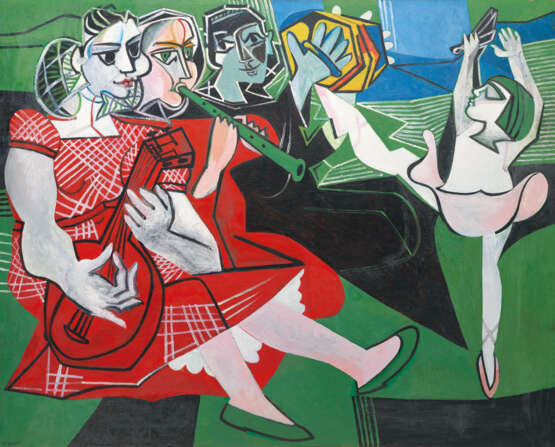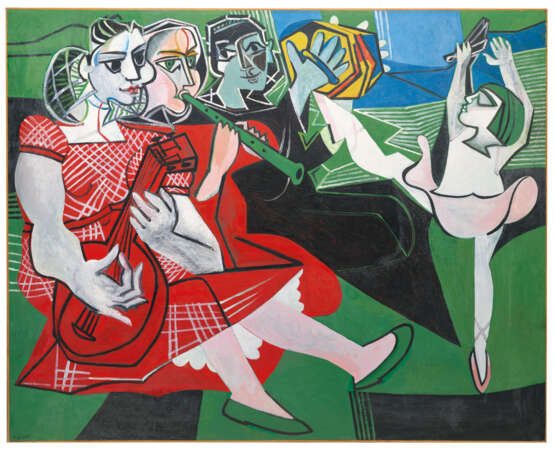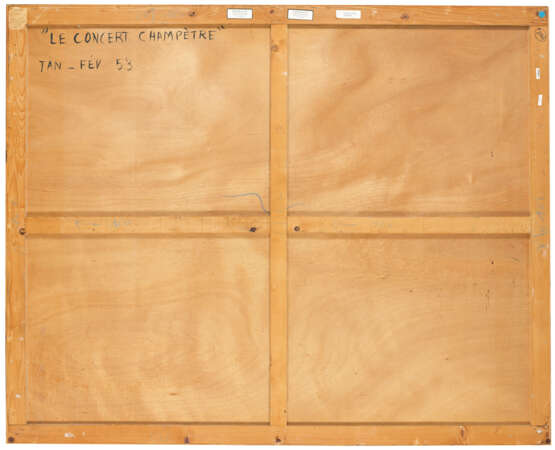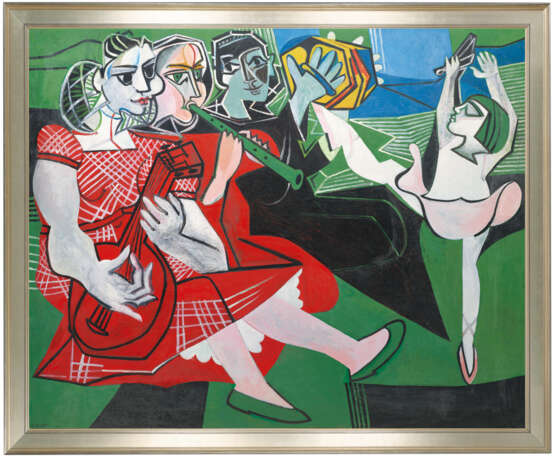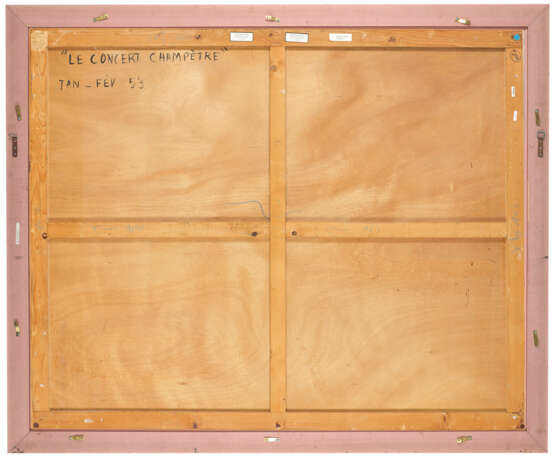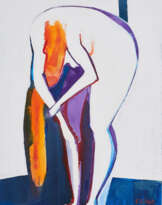ID 1177503
Lot 13 | Françoise Gilot (1921-2023)
Estimate value
€ 200 000 – 300 000
Concert on the Green (Le Concert Champêtre)
signé 'F.GILOT.' (en bas à gauche); daté et inscrit '"LE CONCERT CHAMPÊTRE" JAN-FÉV 53' (au revers)
huile sur panneau
130 x 162 cm.
Peint en janvier-février 1953
signed 'F.GILOT.' (lower left); dated and inscribed '"LE CONCERT CHAMPÊTRE" JAN-FÉV 53' (on the reverse)
oil on panel
51 ¼ x 63 ¾ in.
Painted in January-February 1953
Provenance
Galerie Simon (Daniel-Henry Kahnweiler), Paris (acquis auprès de l'artiste).
Françoise Gilot, Paris (acquis auprès de celle-ci dans les années 1950).
Acquis auprès de celle-ci par le propriétaire actuel le 28 mai 2002.
Literature
F. Gilot et M. Yoakum, Francoise Gilot, Monograph, 1940-2000, Lausanne, 2000, p. 438 (illustré en couleurs, p. 252).
Further details
Les années 50 marquent un tournant dans l’œuvre et la vie de Françoise Gilot. Jusqu’alors, happée par sa relation avec l’artiste Pablo Picasso, elle avait peu d’espace pour travailler. De plus en plus, l’artiste s’octroie cette place. Ses œuvres en deviennent plus colorées, plus grandes, plus vibrantes. En 1953 Françoise Gilot travaille sur les décors de théâtre du ballet Héraclès, de Jeanine Charrat au Théâtre des Champs-Elysées : elle en ressort avec des envies d’espaces et de grandeurs, et un amour nourri pour le mouvement.
Dans le présent, Concert on the Green (Le Concert Champêtre), plusieurs figures accompagnent la jeune Paloma danser. Gilot a pu se représenter elle-même, mais on semble aussi deviner le profil de sa muse de toujours, Geneviève Aliquot. Amis, famille, à cette période l’artiste représente aussi beaucoup ses enfants, Claude et Paloma, en train de jouer, ensemble ou seuls, ou avec elle comme figure maternelle. Les couleurs vibrent, se saturent et l’émotion se ressent dans ses créations.
C’est d’ailleurs ce que cherche l’artiste : créer un « climat émotionnel », de joie ou de tristesse, établissant une connexion particulière avec le spectateur. L’œuvre et l’œil doivent s’unir, résonner, lier leur humeur, marquer l’esprit. La connexion ne peut alors être oubliée.
Ici, l’œuvre est construite sous la forme d’une partition géante, où la couleur et les formes deviennent alors sons, mouvements, danses. Paloma danse, les yeux fermés. La composition de l’œuvre rappelle celle de la toile Liberté, peinte une année plus tôt. Cette fois-ci c’est Paloma, qui semble écrire et décrire, avec ses bras en couronne, sa jambe en jeté, le mot Liberté.
Picasso avait une sorte de leitmotiv à la Wagner pour chaque femme de sa vie : pour Françoise, c’était surtout le vert, Marie-Thérèse la couleur lavande ou encore le jaune citron, et pour Dora Maar le noir. Cette idée du vert remonte à la rencontre de Gilot avec Matisse, où ce dernier, en la voyant, s’imagine faire son portrait avec des cheveux verts et la peau bleue. Piqué et jaloux, Picasso qui n’avait jusque là fait que des dessins de Gilot, la peint, aux cheveux verts, et lui attribue cette couleur dans son imaginaire.
Avec Concert on the Green (Le Concert Champêtre), Gilot se réapproprie pleinement la couleur : les cheveux sont verts, ceux de sa fille aussi, mais surtout le décor, les yeux, la flûte. Son univers est vert, ce n’est pas sa couleur en tant que muse, mais en tant qu’artiste.
C’est d’ailleurs en 1953, année de création de la présente œuvre, que Françoise Gilot devient la seule femme à tourner le dos à Picasso. Avec ses deux enfants, Paloma et Claude, Françoise Gilot quitte Vallauris, et Picasso, pour retourner vivre à Paris, dans son appartement du 9 rue Gay-Lussac.
Artiste à part entière, Françoise Gilot a souvent été ramenée à son histoire à Picasso et à son influence sur son œuvre. Mais Françoise Gilot est celle qui exister artistiquement à part entière, qui a créé sa vie durant plus de 1 600 toiles et 3 600 œuvres sur papier, explorant les styles, les idées, la modernité. Et puis, pour elle, l’art n’est pas une maladie transmissible.
The 1950s marked a turning point in the work and life of Françoise Gilot. Until then, caught up in her relationship with the artist Pablo Picasso, she had had little space in which to work. Increasingly, however, the artist is taking this space for herself. Her works became more colourful, larger and more vibrant. In 1953, Françoise Gilot worked on the stage sets for Jeanine Charrat's ballet Héraclès at the Théâtre des Champs-Elysées: she came away with a desire for space and grandeur, and a love of movement.
In the present, Concert on the Green (Le Concert Champêtre), several figures accompany the young Paloma dancing. Gilot may have represented herself, but we can also make out the profile of her lifelong muse, Geneviève Aliquot. Friends, family - during this period, the artist also often depicted her children, Claude and Paloma, playing together or alone, or with her as a mother figure. The colours vibrate, become saturated and the emotion is felt in her creations.
In fact, that's what the artist is aiming for: to create an 'emotional climate' of joy or sadness, establishing a special connection with the viewer. The work and the eye must unite, resonate, link their moods and leave their mark on the mind. The connection cannot be forgotten.
Here, the work is constructed in the form of a giant score, where colour and form become sound, movement and dance. Paloma dances, eyes closed. The composition of the work is reminiscent of Liberté, painted a year earlier. This time it is Paloma who seems to be writing and describing the word Liberté, with her arms in a crown and her leg in a jeté. Picasso had a sort of Wagner-like leitmotif for each woman in his life: for Françoise, it was mainly green, Marie-Thérèse the colour lavender or lemon yellow, and for Dora Maar black. This idea of green goes back to Gilot's meeting with Matisse, when the latter, on seeing her, imagined drawing her portrait with green hair and blue skin. Piqued and jealous, Picasso, who until then had only made drawings of Gilot, painted her with green hair, and attributed this colour to her in his imagination. In Concert on the Green (Le Concert Champêtre), Gilot fully reappropriates the colour: the hair is green, as is his daughter's, but above all the décor, the eyes and the flute. Her world is green, not her colour as a muse, but as an artist.
It was in 1953, the year the present work was created, that Françoise Gilot became the only woman to turn her back on Picasso. With her two children, Paloma and Claude, Françoise Gilot left Vallauris, and Picasso, to return to live in Paris, in her flat at 9 rue Gay-Lussac. An artist in her own right, Françoise Gilot has often been associated with Picasso and his influence on her work. But Françoise Gilot is one who exists artistically in her own right, who has created over 1,600 canvases and 3,600 works on paper in her lifetime, exploring styles, ideas and modernity. And for her, art is not a transmissible disease.
| Artist: | Francoise Gilot (1921 - 2023) |
|---|---|
| Applied technique: | Oil on panel |
| Auction house category: | Paintings, Watercolors, Drawings, Paintings |
| Artist: | Francoise Gilot (1921 - 2023) |
|---|---|
| Applied technique: | Oil on panel |
| Auction house category: | Paintings, Watercolors, Drawings, Paintings |
| Address of auction |
CHRISTIE'S 9 Avenue Matignon 75008 Paris France | ||||||||||||||
|---|---|---|---|---|---|---|---|---|---|---|---|---|---|---|---|
| Preview |
| ||||||||||||||
| Phone | +33 (0)1 40 76 85 85 | ||||||||||||||
| Fax | +33 (0)1 40 76 85 86 | ||||||||||||||
| Conditions of purchase | Conditions of purchase | ||||||||||||||
| Shipping |
Postal service Courier service pickup by yourself | ||||||||||||||
| Payment methods |
Wire Transfer | ||||||||||||||
| Business hours | Business hours
|
